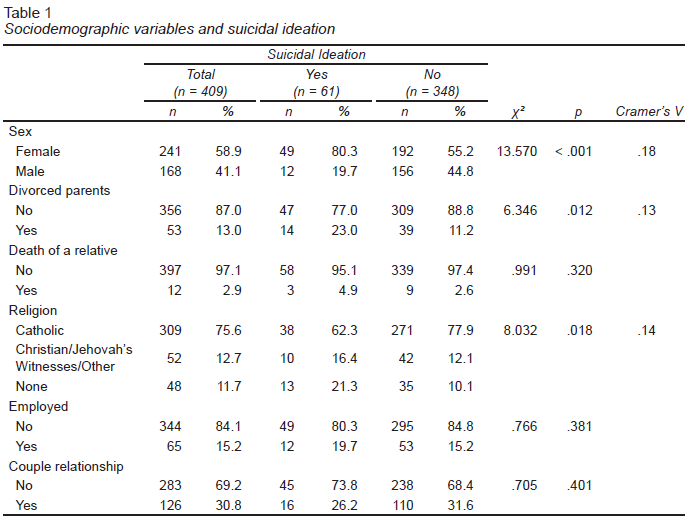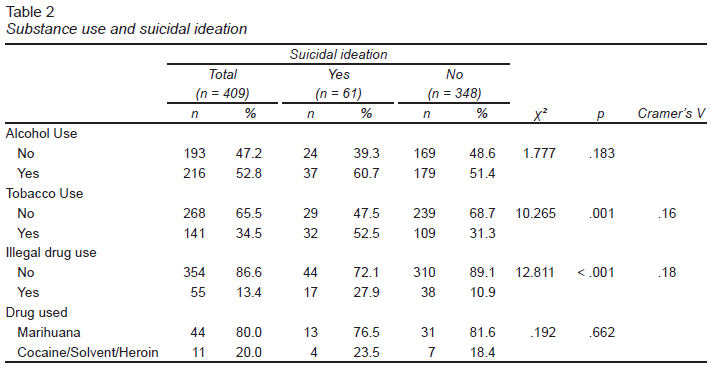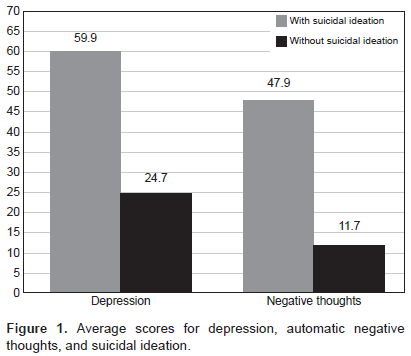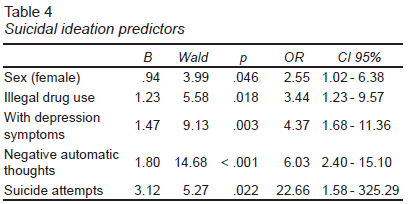Introduction
Suicide constitutes a worldwide public health problem due to its impact, severity, and health costs (World Health Organization [WHO], 2017a). It is one of the main causes of loss of years of life due to premature death, and the second cause of death in adolescents and young people aged 15 to 29 (WHO, 2018). In Mexico, suicide rates in adolescents and young people were 12.6 in men and 3.9 in women (per 100,000) (National Institute of Statistics and Geography [INEGI], 2017) between 2014 and 2016. Both behavior and suicidal ideation vary by gender (WHO, 2014), with men displaying a greater tendency to engage in suicidal behavior, to which end they use more highly effective techniques than women, who tend to show greater suicidal ideation and suicide attempts. Suicide death indicators are therefore higher in men (Gabilondo et al., 2007).
Suicidal ideation is a fundamental element of the process called suicidal behavior, which acts as a trigger for the other components: suicide attempts and completed suicide (Pereira & Cardoso, 2015). Eguiluz (2003) has conceptualized suicidal ideation as a type of intrusive, repetitive thoughts, an individual has about self-inflicted death and the way the person wishes to die. Cognitive-behavioral theory defines it as the emergence of thoughts with contents related to ending one’s life (de la Torre Martí, 2013), while Beck, Kovacs, & Weissman (1979a) describe it as making plans and having wishes to commit suicide.
Suicidal ideation in adolescents is a complex phenomenon due to its cognitive nature in which personal, familial, and contextual elements come into play (Klonsky, May, & Saffer, 2016). However, an important element to explain it is the emergence of a stressful event that creates certain negative emotions and the desire to escape from the situation (de la Torre Martí, 2013). For example, adolescents who have been victims of bullying are at a greater risk of presenting suicidal ideation (Baiden & Tadeo, 2020). Suicidal ideation can therefore be considered as a set of cognitive and affective elements such as the thoughts, desires, and emotions or feelings that determine the suicidal act (Valadez-Figueroa, Chávez-Hernández, Vargas-Valadez, & Ochoa-Orendain, 2019).
Previous research indicates that suicide and suicidal ideation in adolescents are related to certain mental disorders, particularly depression (Eguiluz Romo & Ayala Mira, 2014; Fonseca-Pedrero et al., 2018; WHO, 2017b; Pereira & Cardoso, 2015). The relationship between suicidal ideation and depression is particularly complex since ideation is usually regarded as part of depressive symptomatology, although Hintikka et al. (2009) observed that depressed mood should be considered as a prior condition for suicidal ideation to arise while Kessler, Berglund, Borges, Nock, and Wang (2005) noted, in turn, that depression increased independently from ideas about suicide.
In Mexico, depression is present in 3.3% of the population across the lifespan, and it affects mainly adolescents (de la Peña, Ulloa, & Páez, 1999; Galicia-Moyeda, Sánchez-Velasco, & Robles-Ojeda, 2009; Medina-Mora et al., 2003; Wagner, González-Forteza, Sánchez-García, García-Peña, & Gallo, 2012). It has been reported that 16.6% of high school students in the central area of Mexico present high depression symptoms (Veytia, González, Andrade, & Oudhof, 2012), with a distinctive feature of depression being high frequency of automatic negative thoughts (Estévez & Calvete, 2009), defined as the specific images a person has when faced with situations or events in the environment or with internal events that modify his/her reality. These thoughts appear automatically and are fleeting and unconscious. They focus on issues of loss and failure, becoming evaluative and brief, and are not usually the result of reasoning (Beck, Rush, Shaw, & Emery, 1979b).
Although depression is related to signs such as sadness, hopelessness, and guilt, and these signs can influence the emergence of suicidal ideas in some way (Ceballos-Ospino et al., 2015), few studies have analyzed the relationship between depressive symptoms in adolescents and suicidal ideation, and there are no studies evaluating the relationship between automatic negative thoughts and suicidal ideation in adolescents. It is essential to identify the factors associated with the presence of suicidal ideation in adolescents, since they can constitute an important tool for planning prevention and protection actions.
Therefore, the main objective of this research was to analyze the variables associated with suicidal ideation in teenage high school students, as well as the predictive power of depressive symptoms and automatic negative thoughts. The secondary objective was to evaluate the prevalence of suicidal ideation.
Method
Subjects
This is a descriptive, prospective cross-sectional observational study, with a sample of 409 high school students from a public school in the State of Mexico (Mexico), aged between 15 and 19 (M = 16.46, SD = .96), 41.1% of whom were boys and 58.9% girls. The sampling method used was probabilistic and random.
Measurements
An ad hoc questionnaire was developed for the study in which sociodemographic variables such as age, sex, parental divorce, recent loss of a relative, religion, job, and whether they had a partner were collected. In addition, subjects were asked about alcohol, tobacco, and illegal drug use in the past six months; whether they had been victims of violence; whether they had felt anguish (psychological distress that has an immobilizing effect, produces restlessness or a feeling of being in danger); and whether they had attempted suicide in the past six months and if so, how many attempts they had made.
The Depression Scale of the Center for Epidemiological Studies (CES-D) (Radloff, 1977) was used to assess depression symptoms in the version adapted for the Mexican population by González-Forteza, Jiménez-Tapia, Ramos-Lira, and Wagner (2008). The CESD-R is a screening scale to detect probable cases of depression, containing 35 items with five answer options. Scores on the scale vary between zero and 140 points, with higher scores indicating a greater presence of depression symptoms. The cut-off point for this study was 52 points. The internal consistency of the scale has been satisfactory in studies of Mexican adolescents, with an α of .93 (González-Forteza et al., 2008). In this research, a reliability coefficient of α = .88 was obtained.
The Automatic Thoughts Questionnaire (ATQ-30) (Hollon & Kendall, 1980) was used to evaluate automatic negative thoughts in the version adapted for the Mexican population by Mera-Rosales, Hernández-Pozo, Gómez-Reséndez, Ramírez-Guerrero, and Mata-Mendoza (2011). The questionnaire consists of 30 items referring to negative thoughts such as no one understands me; my life is not going the way I would like; I think something is wrong with me; I wish I could disappear; my life is a problem; I hate myself, and so on. Scores vary between zero and 120 points, with higher scores indicating a greater presence of negative automatic thoughts. The cut-off point used was 30 points. Consistency has proven to be satisfactory in Mexican studies, yielding an α of .95 (Mera-Rosales et al., 2011). Excellent reliability was obtained in this research (α = .97).
For the evaluation of suicidal ideation, the version of the Beck Scale for Suicide Ideation (SSI), drawn up by Beck et al. (1979a) and adapted for the Mexican population by González-Macip, Díaz Martínez, Ortiz León, González Forteza, and González Nuñez (2000) was used. The questionnaire, designed to quantify and evaluate the conscious recurrence of suicidal thoughts, comprises 20 items. Scale scores ranging from zero to 40 points, with higher scores indicating a greater presence of suicidal ideas. Each item is evaluated on a three-point scale, 0 = absent to 2 = maximum intensity of ideation. If the test is to be used with a cut-off point, it is necessary to go to question two of the scale and take the maximum score, as a result of which the cut-off point used was two points. The authors achieved an internal consistency of α = .82 (González-Macip et al., 2000). In this research, a reliability coefficient of α = .88 was obtained.
Procedure
Permission was requested from the school authorities to administer the instruments. Once permission had been granted, the objectives, together with the contents and the fact that the information provided would be confidential, were explained to the students, who were given letters of consent and informed assent to sign. On the day the questionnaire was administered, students who handed in both letters authorizing their participation were given a folder containing the instruments. The questionnaires were administered with verbal instructions in approximately 40 minutes within school hours. Students were told to ask the administrator if they had doubts on how to answer or any other issue.
Statistical analysis
Descriptive analyses were performed to determine the distribution of the variables of interest. Pearson’s Chi-square test and Student’s t test were used to identify the association between suicidal ideation and the presence of depression symptoms and automatic negative thoughts. For the variables in which there were statistically significant differences, effect size was calculated using Cramer’s V and Cohen’s d. A multivariate analysis was also conducted using multinomial logistic regression to determine the variables that predicted suicidal ideation. The OR was calculated for each of the variables together with their 95% confidence intervals. The dependent variable (DV) was the presence of suicidal ideation (without ideation / with ideation), and the independent variables (IV) were those in which statistically significant differences were found: gender, parental divorce, religion, tobacco and drug use, violence, distress, depression symptoms, negative automatic thoughts, and suicide attempts. Statistical analysis was performed using the SPSS program (version 20), with statistical significance being established at p < .05.
Ethical considerations
The study meets the requirements established by the ethics committee of the Center for Research in Medical Sciences (CICMED) and, prior to the administration of the questionnaires, the researchers obtained the assent and informed consent of all the participants, who were guaranteed the confidentiality of the data provided and that the information would solely be used for scientific research purposes.
Results
Of the 409 adolescents who participated in this study, 67.5% (n = 276) reported having felt distressed in the past six months. Moreover, a 16.1% (n = 66) prevalence of students with negative automatic thoughts was found, 14.9% (n = 61) had suicidal ideation, 13.4% (n = 55) had high depression symptoms, and 2.7% (n = 11) had attempted suicide.
Regarding the association between sociodemographic variables (Table 1) and suicidal ideation, it was observed that being a girl (χ2 = 13.570; p <.001; V = .18), having divorced parents (χ2 = 6.346; p = .012; V = .13) and professing Catholicism (χ2 = 8.032; p = .018; V = .14) were associated with a greater presence of suicidal ideation.
As for substance use (Table 2), although suicidal ideation was not related to alcohol consumption, it was related to tobacco (χ2 = 10.265; p = .001; V = .16) and drug use (χ2 = 12.811; p < .001; V = .18). It also showed an association with having suffered psychological and/or physical violence (49.2 vs. 17.8; χ2 = 29.286; p <.001; V = .27).
With respect to psychological variables (Table 3) and the presence of suicidal ideation, an association was found with having suffered anxiety in the past six months (χ2 = 24.888; p < .001; V = .25), high depressive symptoms (χ2 = 127.907; p < .001; V = .56), automatic negative thoughts (χ2 = 129.474; p < .001; V = .56), and suicide attempts (χ2 = 51.444; p < .001; V = .36).
As for the relationship between the presence of suicidal ideation and the mean scores obtained in the CESD-R (depression) and the ATQ-30 (automatic negative thoughts), significantly higher scores were obtained (t = 11.082; p < .001; d = 1.73) in depression (59.9 vs. 24.7) and automatic negative thoughts (47.9 vs. 11.7; t = 9.142; p < .001; d = 1.54) among those who reported suicidal ideation (Figure 1).
The results of the logistic regression analyses performed to identify the variables that determined a greater risk of presenting suicidal ideation (Table 4) show that being a girl (OR = 2.55, 95% CI [1.02, 6.38]); using drugs (OR = 3.44, 95% CI [1.23, 9.57]); presenting symptoms of depression (OR = 4.37, 95% CI [1.68, 11.36]); having automatic negative thoughts (OR = 6.03, 95% CI [2.40, 15.10]); and having attempted suicide (OR = 22.66, 95% CI [1.58, 325.29]) increased the probability of presenting suicidal ideas.
Discussion and conclusion
The main objective of this research was to analyze the variables associated with suicidal ideation among teenage high school students, as well as to observe the predictive power of depressive symptoms and automatic negative thoughts. It was found that the presence of depressive symptoms was similar (13.4%) to that reported by other studies with similar samples, which also used the CESD-R scale, in which a prevalence between 14.5% (González-Forteza et al., 2011) and 15.5% (Veytia et al., 2012) was found. The small difference found may be because the age range and methodology used were different. Moreover, as in previous studies (González-Forteza, Hermosillo de la Torre, Vacio-Muro, Peralta, & Wagner, 2015), the proportion of cases with high depressive symptoms is greater among girls (81.8%). Likewise, regarding the prevalence of the presence of automatic negative thoughts (16.1%), in our study, girls showed the highest prevalence (75.8%) of automatic negative thoughts (such as I’m not good, no-one understands me, I wish I were a better person, I wonder why I am never successful, I am very weak). This concurs with the studies by Gómez-Marquet (2007), in which it was observed that women experience negative and catastrophic ideas more frequently than men, and by Calvete (2005), in which it was observed that women, unlike men, are more likely to present internalizing problems, with a predominance of negative self-dialogue, mainly including thoughts that express a negative vision of themselves, self-blame, and rejection.
In the literature there is a prevalence of suicidal ideation ranging between the 9.9% found by dos Santos, Marcon, Espinosa, Baptista, & Paulo (2017) in Brazil, with university adolescents and young adults, and the 55.4% reported by Castro-Díaz et al. (2013) in Colombia. Intermediate prevalence rates were reported by Pereira and Cardoso (2015) with university students from Portugal (12.6%) and by Fonseca-Pedrero et al. (2018) in Spain (32.3%). In our study, the prevalence of suicidal ideation was 14.9%. The discrepancies in prevalence rates found may be because a range of instruments were used to determine this problem, as well as the different characteristics and specific conditions presented by each sample analyzed in the various countries. It should also be noted that in this study an association was found between suicidal ideation and sex, since being a woman increases the probability of presenting suicidal ideas almost threefold. These differences are linked, among other aspects, to the greater difficulty on the part of males in admitting that they have a problem and asking for help in situations of emotional distress and engaging more frequently in suicidal behaviors (Möller-Leimkühler, 2003), unlike women, who have a higher risk of suicidal ideation than men (Fonseca-Pedrero et al., 2018; Gabilondo et al., 2007; Siabato Macias & Salamanca Camargo, 2015; Silva et al., 2017). Likewise, from the 61 adolescents who reported having suicidal ideation, 11 had already attempted suicide, mainly girls (10 vs. 1). This aspect concurs with the findings of some studies that indicate that both suicidal ideation and suicide attempts are more common in women (Calvo, Sánchez, & Tejada, 2003; Siabato Macias & Salamanca Camargo, 2015). These differences may be due to the predominance in women of emotional variables such as depression, differences in the expression of psychological distress, and the way they cope, compared to men, with adversities within the context in which they develop, because coping is more cognitive and emotional. Likewise, the results of this research reveal that if there is a history of suicide attempts, the probability of having suicide plans or ideas increases more than twenty-two times. This is, therefore, the main predictor of the risk of suicidal ideation. This data is linked to the fact that women engage in more suicide attempts (de la Peña, 2017), which are more a cry for help and it means they can be rescued. However, if the trigger factor remains, so will the idea of attempting suicide.
At the same time, living in an unstable family nucleus or having separated parents has been regarded as a risk factor for developing suicidal ideas and behaviors (Pérez-Prada, Martínez-Baquero, Vianchá-Pinzón, & Avendaño-Prieto, 2017). This research reaffirms the above since an association was observed between the emergence of suicidal ideas and the fact of adolescents having separated or divorced parents.
As for religion, there is an association between professing Catholicism and the presence of suicidal ideation, since 62.3% of those who present suicidal ideation say they practice this religion. This data appears to contradict studies conducted in Mexico and other countries, which underline the fact that practicing a religion is a protective factor that will contribute to emotional well-being (dos Santos et al., 2017; Taliaferro, Rienzo, Pigg, Miller, & Dodd, 2009). In Latin America, especially, the Christian-Catholic religion regards suicide and its derivatives (suicidal behavior and ideation) as a mortal sin, a shameful and unworthy act, which reduces suicide attempts (Barreira, 2017; Ballesteros et al., 2010; Hernández-Bringas & Flores-Arenales, 2011). In a meta-analysis performed by Wu, Wang, and Jia (2015), a protective effect of religiosity was found against completed suicide, especially among the elderly population. However, this effect varied according to the cultural and religious context. Perhaps a relevant aspect to investigate in this context is whether this protective factor occurs across all age groups, since we are talking about a study conducted on adolescents through an anonymous survey. Moreover, religion may protect against suicidal behavior but still it fails to inhibit covert aspects such as suicidal thoughts.
Likewise, the use of psychoactive substances such as tobacco and illegal drugs may pose a significant risk for the development of suicidal ideas. This research shows a clear relationship between the use of these substances and suicidal ideation. In this regard, previous research has analyzed the effect of nicotine in relation to the emergence of suicidal thoughts, finding that it not only leads to the emergence of these ideas, but also to a greater tendency to engage in suicidal behaviors (Castro-Díaz et al., 2013; Kenny, File, & Rattray, 2001; Silva et al., 2017), while drug use leads to suicidal ideation and unplanned suicide attempts (Siabato Macias & Salamanca Camargo, 2015). Our research highlights the fact that using illegal drugs increases the probability of developing ideas about suicide nearly fourfold.
At the same time, depression was significantly associated with suicidal ideation, with the risk of developing ideas or plans to commit suicide increasing nearly fourfold if depressive symptoms were present. Some studies report that this disorder is the one most associated with suicide and one of the main risk factors for suicidal behavior. It has been argued that, in these cases, suicide appears to be the only solution to this disorder (dos Santos et al., 2017; Castro-Díaz et al., 2013; Siabato Macias & Salamanca Camargo, 2015; Silva et al., 2017). An important part of the maintenance of this pathology are negative automatic thoughts (Estévez & Calvete, 2009), which were independently associated with suicidal ideation, and whose presence increased the probability of developing ideation sixfold. The results of this study therefore show that depression symptoms and automatic negative thoughts predict the emergence of suicidal ideas.
The limitations that may affect this type of study must be considered, because the fact that it is cross-sectional makes it impossible to verify the time relationship between cause and effect. At the same time, since the sample analyzed only included adolescent students from a public high school, the results are not generalizable to adolescents from the general population or to students at private schools. It should be noted that this research has also important strengths, since it evaluates the prevalence of automatic negative thoughts in adolescents and is the first study to date to analyze the association between depression symptoms, automatic negative thoughts, and the presence of suicidal ideation in adolescent students. It also provides information on risk factors, which allows for a broader view of this problem.
The data obtained in this study suggest that suicidal ideation is a phenomenon involving multiple risk factors that interact in a complex way. Since one of the main suicide prevention strategies is the identification of individuals with risk factors, immediate actions are required, for which it is recommended that professionals consider the fact that adolescents require preventive care from an early age. The development of a depressive disorder should be avoided in the first instance through the timely identification of symptoms, which, together with negative automatic thoughts, may influence the emergence of suicidal ideas. Future studies with larger samples ‒including students from public and private schools from different states‒, and the use of longitudinal data collection methods that will make it possible to establish causality, should be conducted to explore this public health issue in greater depth.




